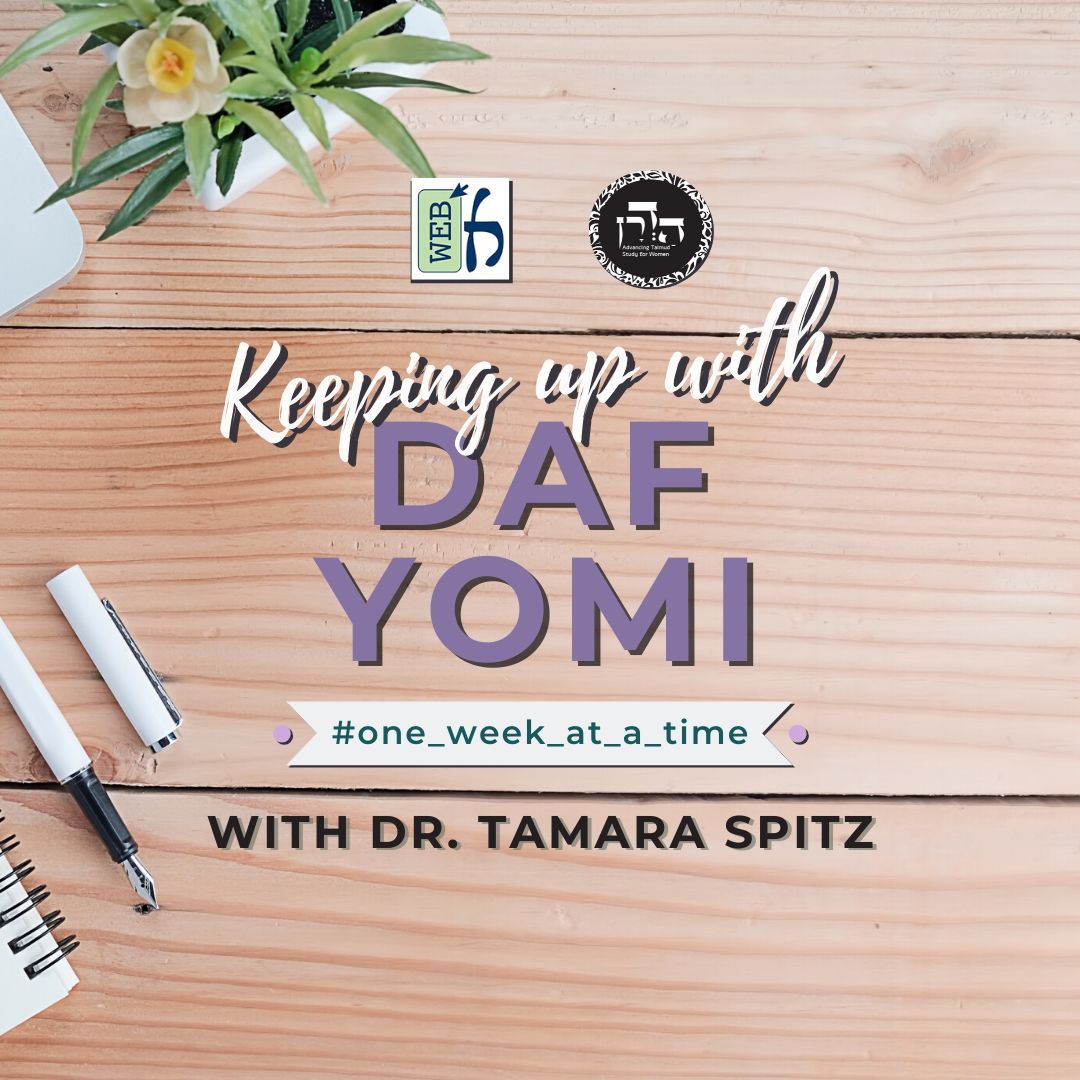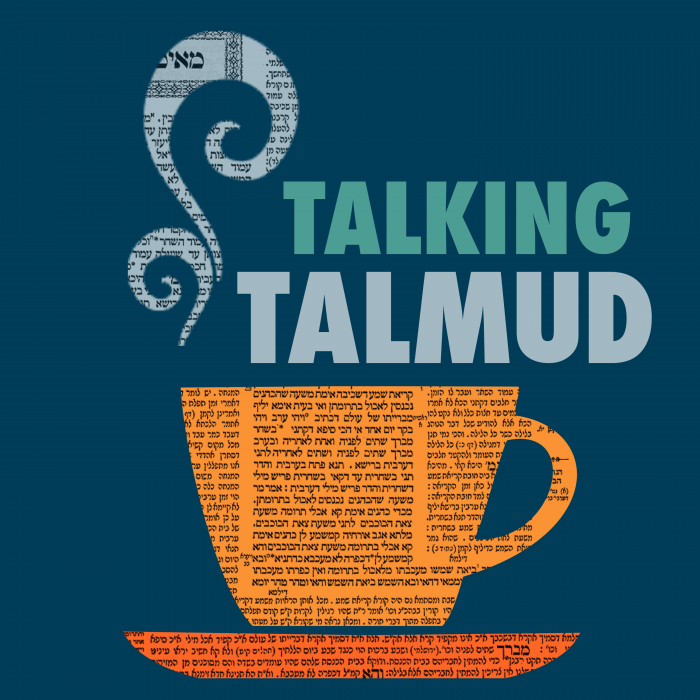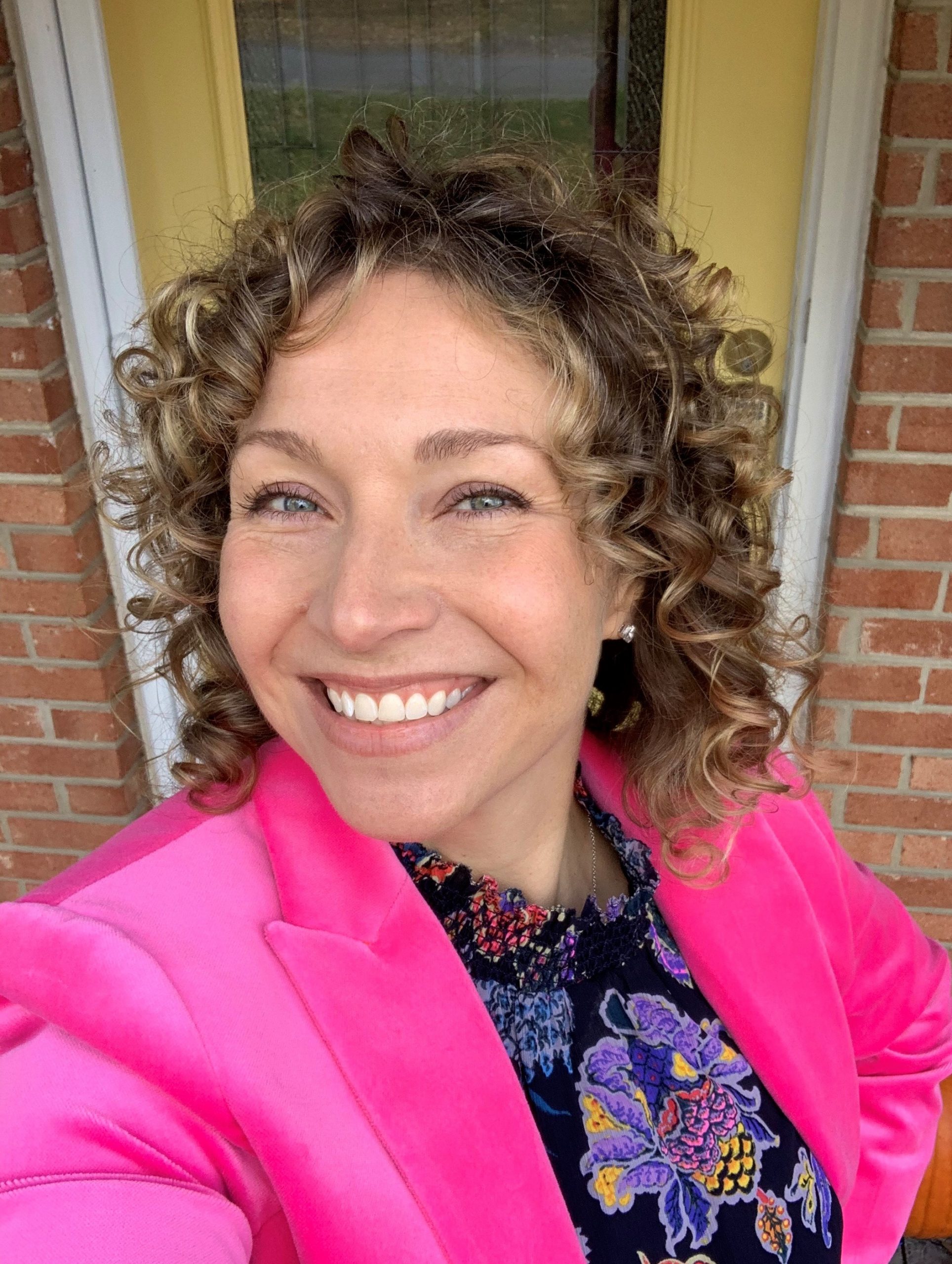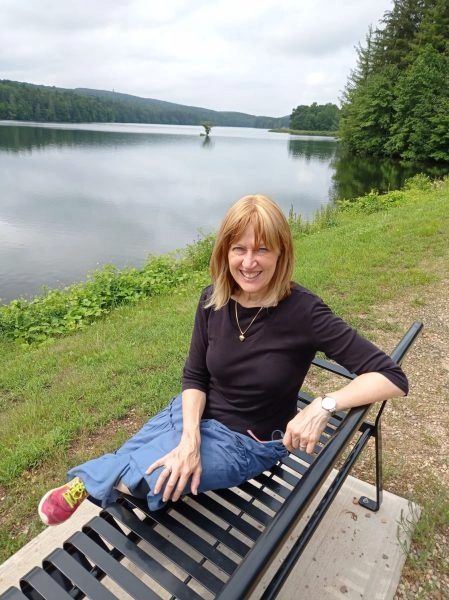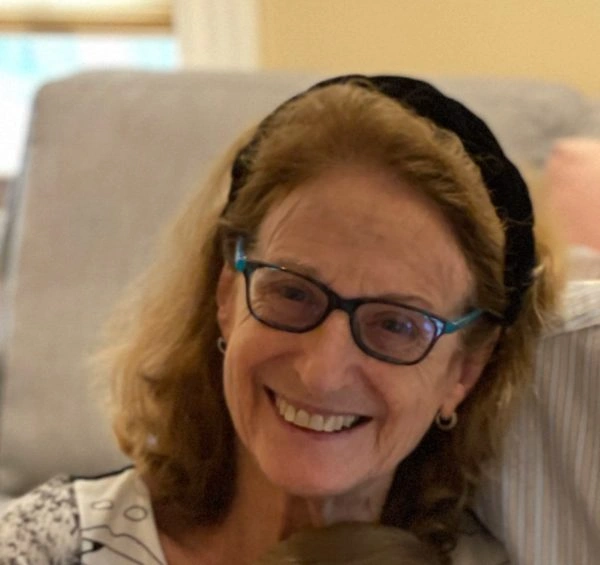The gemara determines who said what in the dispute between Rabbi Yoshiya and Rabbi Yonatan regarding mixing the blood. Rami bar Hama asks some questions about something creating a separation between the blood and a utensil. Where does the Kohen Gadol stand when he puts the blood on the inner altar? How many does he do? In which direction is it done (up/down)? Which corner does he start with and what is the direction in which he continues from there? There is a dispute between Rabbi Akiva and Rabbi Yossi Hagalili – what is the basis for the dispute?
Yoma 58
Share this shiur:
This week’s learning is sponsored by Caroline Bollag l’ilui nishmat Pinchas ben Menashe Peyser.
Want to dedicate learning? Get started here:


Today’s daily daf tools:
This week’s learning is sponsored by Caroline Bollag l’ilui nishmat Pinchas ben Menashe Peyser.
Today’s daily daf tools:
Delve Deeper
Broaden your understanding of the topics on this daf with classes and podcasts from top women Talmud scholars.
New to Talmud?
Check out our resources designed to help you navigate a page of Talmud – and study at the pace, level and style that fits you.
The Hadran Women’s Tapestry
Meet the diverse women learning Gemara at Hadran and hear their stories.
Yoma 58
רַבִּי יוֹנָתָן אוֹמֵר: מִזֶּה בִּפְנֵי עַצְמוֹ, וּמִזֶּה בִּפְנֵי עַצְמוֹ. אָמַר לוֹ רַבִּי יֹאשִׁיָּה: וַהֲלֹא כְּבָר נֶאֱמַר: ״אַחַת״!
Rabbi Yonatan says: He presents from this one, the bull’s blood, by itself, and he presents from that one, the goat’s blood, by itself and does not mix them. Rabbi Yoshiya said to him: But wasn’t it already stated: “And Aaron shall make atonement upon its corners once a year; with the blood of the sin-offering of atonement” (Exodus 30:10), which indicates that the High Priest does not present twice?
אָמַר לוֹ רַבִּי יוֹנָתָן, וַהֲלֹא כְּבָר נֶאֱמַר: ״מִדַּם הַפָּר וּמִדַּם הַשָּׂעִיר״! אִם כֵּן, לָמָּה נֶאֱמַר ״אַחַת״? לוֹמַר לָךְ: אַחַת וְלֹא שְׁתַּיִם מִדַּם הַפָּר, אַחַת וְלֹא שְׁתַּיִם מִדַּם הַשָּׂעִיר.
Rabbi Yonatan said to him: But wasn’t it already stated: “Of the blood of the bull and of the blood of the goat” (Leviticus 16:18), which teaches that each set of sprinklings must be performed by itself? If so, why is “once” stated? This verse comes to tell you that he must perform the rite once and not perform two sets of sprinklings from the blood of the bull; and likewise he must perform the rite once and not perform two sets of sprinklings from the blood of the goat. From the blood of each of the animals, the High Priest presents only one set of sprinklings. This shows that Rabbi Yoshiya and Rabbi Yonatan indeed disagree with regard to this issue.
תַּנְיָא אִידַּךְ: ״וְלָקַח מִדַּם הַפָּר וּמִדַּם הַשָּׂעִיר״ — שֶׁיִּהְיוּ מְעוֹרָבִין זֶה בָּזֶה. אַתָּה אוֹמֵר שֶׁיִּהְיוּ מְעוֹרָבִין זֶה בָּזֶה, אוֹ אֵינוֹ אֶלָּא מִזֶּה בִּפְנֵי עַצְמוֹ וּמִזֶּה בִּפְנֵי עַצְמוֹ? תַּלְמוּד לוֹמַר: ״אַחַת״. וּסְתָמָא כְּרַבִּי יֹאשִׁיָּה.
It was taught in another baraita: “And he shall take of the blood of the bull and of the blood of the goat” (Leviticus 16:18). This verse teaches that the blood of the bull and the goat should be mixed together. Do you say that they should be mixed together, or perhaps that is not the case; rather, he presents from this blood by itself and from that by itself? Therefore, the verse states: “Once.” The Gemara comments: And this unattributed baraita is in accordance with the opinion of Rabbi Yoshiya, who said the two sets of blood are mixed, as stated in the mishna.
נָתַן אֶת הַמָּלֵא בָּרֵיקָן וְכוּ׳. בְּעָא מִינֵּיהּ רָמֵי בַּר חָמָא מֵרַב חִסְדָּא: הִנִּיחַ מִזְרָק בְּתוֹךְ מִזְרָק, וְקִבֵּל בּוֹ אֶת הַדָּם, מַהוּ? מִין בְּמִינוֹ חוֹצֵץ, אוֹ אֵינוֹ חוֹצֵץ?
§ It was taught in the mishna that after the High Priest poured the bull’s blood into the goat’s blood, he placed the blood from the full bowl into the empty bowl, to mix the blood well. Rami bar Ḥama raised a dilemma before Rav Ḥisda: What is the halakha if he placed one bowl inside a second bowl and collected the blood in the inner bowl? Does one type of object mingled with another of its own type interpose, which would mean that the priest has not collected the blood himself, as the outer bowl interposed between him and the vessel? Or perhaps an object of one type does not interpose for another object of the same type, and therefore the two bowls are considered one object.
אֲמַר לֵיהּ, תְּנֵיתוּהָ: נָתַן אֶת הַמָּלֵא בָּרֵיקָן. מַאי לָאו: הוֹשִׁיב מִזְרָק מָלֵא לְתוֹךְ מִזְרָק רֵיקָן?
Rav Ḥisda said to him: We have already learned the answer to this question in the mishna: He placed the blood from the full bowl into the empty bowl. What, is it not correct to infer from this statement that he inserted the full bowl into the empty bowl?
לָא, עֵירָה מִזְרָק מָלֵא לְתוֹךְ מִזְרָק רֵיקָן. הָא תְּנָא לֵיהּ רֵישָׁא: עֵירָה דַּם הַפָּר לְתוֹךְ דַּם הַשָּׂעִיר! כְּדֵי לְעָרְבָן יָפֶה יָפֶה.
Rami bar Ḥama responded: No, it means that he poured the full bowl into an empty bowl. Rav Ḥisda said to him: But this statement is unnecessary, as the tanna of the mishna already taught the requirement to pour from one vessel into another in the first clause: He poured the blood of the bull into the blood of the goat. The subsequent phrase: He placed the full into the empty, must therefore refer to the placement of one vessel inside another. Rami bar Ḥama responded: No, it means that he pours the blood from the full bowl into the empty bowl a second time in order to mix them very well. To this end, he pours from one vessel into the other before again pouring the mixture back into the first vessel, thereby mixing them thoroughly.
תָּא שְׁמַע: הָיָה עוֹמֵד עַל גַּבֵּי כְּלִי, אוֹ עַל גַּבֵּי רֶגֶל חֲבֵירוֹ — פָּסוּל! שָׁאנֵי רֶגֶל, דְּלָא מָצֵי מְבַטֵּיל לֵיהּ.
The Gemara suggests: Come and hear a solution to this question: If a priest performed the Temple service while he was standing on top of a vessel, or on the foot of another priest, his service is disqualified, as the priest must stand directly on the floor of the Temple. The fact that the foot of another person is considered an interposition proves that one type serves as an interposition with regard to another object of the same type. The Gemara rejects this contention: A foot is different, as he cannot nullify it. The foot of another person cannot be considered nullified with respect to the priest’s foot, but in the case of a vessel it is possible to say that one vessel is nullified in favor of another vessel.
אִיכָּא דְאָמְרִי, הָכִי בְּעָא מִינֵּיהּ: דֶּרֶךְ שֵׁירוּת בְּכָךְ, אוֹ אֵין דֶּרֶךְ שֵׁירוּת בְּכָךְ? תָּא שְׁמַע, דְּתָנָא דְּבֵי רַבִּי יִשְׁמָעֵאל: ״אֶת כׇּל כְּלֵי הַשָּׁרֵת אֲשֶׁר יְשָׁרְתוּ בָם בַּקּוֹדֶשׁ״ — שְׁנֵי כֵלִים וְשֵׁירוּת אַחַת.
Some say that Rami bar Ḥama did not refer to the issue of interposition at all. Rather, this is the dilemma he raised before Rav Ḥisda: Is placing one vessel inside another vessel a proper manner of service; or is this not a proper manner of service, and if one does so his service is disqualified? The Gemara answers: Come and hear that which the school of Rabbi Yishmael taught: “And they shall take all the service vessels, with which they serve in the Sanctuary” (Numbers 4:12). This verse is referring to two vessels and one service, which indicates that this is a proper manner of service.
בְּעָא מִינֵּיהּ רָמֵי בַּר חָמָא מֵרַב חִסְדָּא: הִנִּיחַ סִיב בְּתוֹךְ הַמִּזְרָק, וְקִבֵּל בּוֹ אֶת הַדָּם, מַהוּ: מִין בְּשֶׁאֵינוֹ מִינוֹ חוֹצֵץ, אוֹ אֵינוֹ חוֹצֵץ? כֵּיוָן דִּמְחַלְחֵל — לָא חָיֵיץ, אוֹ דִילְמָא לָא שְׁנָא?
§ Rami bar Ḥama raised another dilemma before Rav Ḥisda along the same lines: What is the halakha if he placed bast, the material that grows around palm trees, inside the bowl, and collected the blood in the bowl through the bast, such that the blood seeps through into the bowl? Does one type of object mixed with another not of its own type interpose; or perhaps it does not interpose? Could one say that since the blood seeps through, it therefore does not interpose? Or perhaps this case is no different, and as there is a foreign object in the vessel it is considered an interposition even if the blood seeps through.
אֲמַר לֵיהּ, תְּנֵינָא: זוֹלֵף וְהוֹלֵךְ עַד שֶׁמַּגִּיעַ לַסְּפוֹג! שָׁאנֵי מַיָּא דִּקְלִישִׁי.
Rav Ḥisda said to him in response: We already learned this matter with regard to sanctifying the purification waters, i.e., the water mixed with ashes of the red heifer. If a sponge was placed inside the container of water, the water in the sponge is disqualified and the priest may not sprinkle with it. How should he proceed? He sprinkles from the water and continues until he reaches the sponge. This shows that the presence of the sponge in the water container is not considered an interposition for the water in the container, despite the fact that it itself is unfit for the service. Rami bar Ḥama replied: This is no proof. Water is different, as it is thin and therefore it certainly seeps through the sponge and reaches the bowl; whereas the thicker blood will perhaps not seep into the fiber.
אִיכָּא דְאָמְרִי, הָכִי פְּשַׁט לֵיהּ: בְּדָם — כָּשֵׁר. בְּקוֹמֶץ — פָּסוּל.
Some say that this is how Rav Ḥisda resolved the problem of placing the bast in the bowl for Rami bar Ḥama: In the case of the blood it is valid, as blood passes through, and the bast does not obstruct it. However, in the case of the handful of a meal-offering, which must be sanctified in a vessel immediately after the handful is taken, if he put bast in a vessel and placed the handful on top of it, it is disqualified. The reason is that the handful of a meal-offering consists of dough, which does not pass through the bast, and it is therefore considered a proper interposition.
מַתְנִי׳ ״וְיָצָא אֶל הַמִּזְבֵּחַ אֲשֶׁר לִפְנֵי ה׳״, זֶה מִזְבַּח הַזָּהָב. הִתְחִיל מְחַטֵּא וְיוֹרֵד, מֵהֵיכָן הוּא מַתְחִיל? מִקֶּרֶן מִזְרָחִית צְפוֹנִית, צְפוֹנִית מַעֲרָבִית, מַעֲרָבִית דְּרוֹמִית, דְּרוֹמִית מִזְרָחִית. מָקוֹם שֶׁהוּא מַתְחִיל בַּחַטָּאת עַל מִזְבֵּחַ הַחִיצוֹן — מִשָּׁם הָיָה גּוֹמֵר עַל מִזְבֵּחַ הַפְּנִימִי.
MISHNA: It is stated: “And he shall go out to the altar that is before the Lord, and make atonement for it; and he shall take of the blood of the bull, and of the blood of the goat, and place it upon the corners of the altar round about” (Leviticus 16:18). This altar is the golden altar, since the outer altar is not before the Lord in the Sanctuary. He began to cleanse the altar, sprinkling the blood downward. From where does he begin? He begins from the northeast corner, and proceeds to the northwest corner, and then to the southwest corner, and finally to the southeast corner. A way to remember this is: At the place where he begins sprinkling the blood for a sin-offering sacrificed on the outer altar, the southeast corner, there he finishes sprinkling the blood on the inner altar.
רַבִּי אֱלִיעֶזֶר אוֹמֵר: בִּמְקוֹמוֹ הָיָה עוֹמֵד וּמְחַטֵּא.
Rabbi Eliezer says: The priest would not circle the altar; rather, he stood in one place and sprinkled the blood from there. Since the altar was only one square cubit, he could sprinkle the blood on all four corners without moving.
וְעַל כּוּלָּן הָיָה נוֹתֵן מִלְּמַטָּה לְמַעְלָה, חוּץ מִזּוֹ שֶׁהָיְתָה לְפָנָיו, שֶׁהָיָה נוֹתֵן מִלְּמַעְלָה לְמַטָּה. הִזָּה עַל טׇהֳרוֹ שֶׁל מִזְבֵּחַ שֶׁבַע פְּעָמִים, וּשְׁיָרֵי הַדָּם הָיָה שׁוֹפֵךְ עַל יְסוֹד מַעֲרָבִי שֶׁל מִזְבֵּחַ הַחִיצוֹן, וְשֶׁל מִזְבֵּחַ הַחִיצוֹן הָיָה שׁוֹפֵךְ אֶל יְסוֹד דְּרוֹמִי. אֵלּוּ וְאֵלּוּ מִתְעָרְבִין בָּאַמָּה וְיוֹצְאִין לְנַחַל קִדְרוֹן, וְנִמְכָּרִין לַגַּנָּנִין לְזַבֵּל, וּמוֹעֲלִין בָּהֶן.
And on all the corners he would present the blood from below upward, except for that corner that was directly before him, on which he would present the blood from above downward. He sprinkled blood on the pure gold of the altar seven times after clearing away the ashes. And he would pour the remainder of the blood on the western base of the outer altar. On a related topic, the mishna teaches that he would pour the remaining blood of an offering, after it was sprinkled, on the outer altar, on its southern base. These remainders of blood from the outer altar and those remainders of blood from the inner altar are mixed in the canal beneath the altar and flow out with the water used to rinse the area to the Kidron River. This water was sold to gardeners for use as fertilizer. The gardeners paid for this water and thereby redeemed it from its sanctity. Failure to do so would render them guilty of misuse of consecrated property.
גְּמָ׳ תָּנוּ רַבָּנַן: ״וְיָצָא אֶל הַמִּזְבֵּחַ״, מָה תַּלְמוּד לוֹמַר? אָמַר רַבִּי נְחֶמְיָה: לְפִי שֶׁמָּצִינוּ בְּפַר הַבָּא עַל כׇּל הַמִּצְוֹת, שֶׁכֹּהֵן עוֹמֵד חוּץ לַמִּזְבֵּחַ וּמַזֶּה עַל הַפָּרוֹכֶת בְּשָׁעָה שֶׁהוּא מַזֶּה, יָכוֹל אַף זֶה כֵּן,
GEMARA: The Sages taught: “And he shall go out to the altar” (Leviticus 16:18). What is the meaning when the verse states this? Upon his exit, after sprinkling toward the curtain, the High Priest must necessarily reach the golden altar. Rabbi Neḥemya said: It is because we find with regard to the bull brought for a violation of all the mitzvot, i.e., the bull that must be brought in the event that the community errs with regard to any of the mitzvot, which is called the bull for an unwitting communal sin, that when the priest sprinkles toward the curtain he stands past the altar and sprinkles back toward the curtain; therefore, one might have thought that here, too, the rite should be performed in the same manner.
תַּלְמוּד לוֹמַר: ״וְיָצָא אֶל הַמִּזְבֵּחַ״. הֵיכָן הָיָה — לִפְנִים מִן הַמִּזְבֵּחַ.
Therefore, the verse states: “And he shall go out to the altar.” Where was he before? He was on the inner side of the altar, i.e., the western side, close to the curtain, when he sprinkled, not on the outer side of the altar.
תַּנְיָא אִידַּךְ: ״לִפְנֵי ה׳״, מָה תַּלְמוּד לוֹמַר? אָמַר רַבִּי נְחֶמְיָה: לְפִי שֶׁמָּצִינוּ בְּפַר וְשָׂעִיר שֶׁל יוֹם הַכִּפּוּרִים שֶׁכֹּהֵן עוֹמֵד לִפְנִים מִן הַמִּזְבֵּחַ וּמַזֶּה עַל הַפָּרוֹכֶת בְּשָׁעָה שֶׁהוּא מַזֶּה, יָכוֹל אַף זֶה, כֵּן,
It was taught in another baraita: With regard to the bull for an unwitting communal sin the verse states: “And he shall sprinkle seven times before the Lord in front of the curtain” (Leviticus 4:17). What is the meaning when the verse states: Before the Lord? Rabbi Neḥemya said: It is because we find with regard to the bull and the goat of Yom Kippur that when he sprinkles the High Priest stands on the inner side of the altar, close to the curtain, and sprinkles toward the curtain; therefore, one might have thought that here, too, in the case of the bull for an unwitting communal sin, it should be the same rite.
תַּלְמוּד לוֹמַר: ״מִזְבַּח קְטֹרֶת הַסַּמִּים לִפְנֵי ה׳ אֲשֶׁר בְּאֹהֶל מוֹעֵד״ — מִזְבֵּחַ לִפְנֵי ה׳, וְאֵין כֹּהֵן לִפְנֵי ה׳. הָא כֵּיצַד? עוֹמֵד חוּץ לַמִּזְבֵּחַ וּמַזֶּה.
Therefore, the verse states: “And the priest shall put the blood upon the corners of the altar of sweet incense before the Lord, which is in the Tent of Meeting” (Leviticus 4:7). This verse teaches that the altar is before the Lord, but the priest is not before the Lord. How so? The priest stands on the outer side of the altar and sprinkles.
הִתְחִיל מְחַטֵּא וְיוֹרֵד וְכוּ׳. תָּנוּ רַבָּנַן: הִתְחִיל מְחַטֵּא וְיוֹרֵד. מֵהֵיכָן הָיָה מַתְחִיל? מִקֶּרֶן מִזְרָחִית דְּרוֹמִית, דְּרוֹמִית מַעֲרָבִית, מַעֲרָבִית צְפוֹנִית, צְפוֹנִית מִזְרָחִית, דִּבְרֵי רַבִּי עֲקִיבָא. רַבִּי יוֹסֵי הַגְּלִילִי אוֹמֵר: מִקֶּרֶן מִזְרָחִית צְפוֹנִית, צְפוֹנִית מַעֲרָבִית, מַעֲרָבִית דְּרוֹמִית, דְּרוֹמִית מִזְרָחִית.
§ The mishna taught: He began to cleanse the altar, sprinkling the blood downward. The Sages taught in a baraita: He began to cleanse downward. From where would he begin? He would begin from the southeast corner of the altar, and from there he would turn to the southwest corner, onward to the northwest corner, and finally to the northeast corner. This is the statement of Rabbi Akiva. Rabbi Yosei HaGelili says: He began from the northeast corner, from which he turned to the northwest corner, then to the southwest corner, and finished at the southeast corner.
מָקוֹם שֶׁרַבִּי יוֹסֵי הַגְּלִילִי מַתְחִיל, שָׁם רַבִּי עֲקִיבָא פּוֹסֵק. מָקוֹם שֶׁרַבִּי עֲקִיבָא מַתְחִיל, שָׁם רַבִּי יוֹסֵי הַגְּלִילִי פּוֹסֵק.
The Gemara notes: The place where the High Priest begins according to the opinion of Rabbi Yosei HaGelili, i.e., the northeast corner, there is where Rabbi Akiva says he ends; and the place where the High Priest begins according to the opinion of Rabbi Akiva, the southeast corner, there is where Rabbi Yosei HaGelili says he ends.
דְּכוּלֵּי עָלְמָא מִיהָא, בְּהָהוּא קֶרֶן דְּפָגַע בְּרֵישָׁא — לָא עָבֵיד. מַאי טַעְמָא? אָמַר שְׁמוּאֵל, דְּאָמַר קְרָא: ״וְיָצָא אֶל הַמִּזְבֵּחַ״, עַד דְּנָפֵיק מִכּוּלֵּיהּ מִזְבֵּחַ.
The Gemara asks: Everyone agrees, in any case, that he does not perform the service at the corner that he encounters first. Since the High Priest approaches the altar from the west side, the first corner he encounters is located on the west side. What is the reason for this? Shmuel said: The reason is that the verse states: “And he shall go out to the altar,” which indicates that he does not begin until he goes out from the sacred area beyond the entire area of the altar. At this stage, he is no longer on the western side of the altar but on its eastern side.
וּלְרַבִּי עֲקִיבָא, נַקֵּיף דֶּרֶךְ יָמִין? לֵימָא בִּדְרָמֵי בַּר יְחֶזְקֵאל קָא מִיפַּלְגִי,
The Gemara asks: And according to the opinion of Rabbi Akiva, let him go around via the right. Since the High Priest is standing at the eastern side of the altar facing the west, the corner on his right is the northeast one. Let us say that they disagree with regard to the opinion of Rami bar Yeḥezkel.
דְּאָמַר רָמֵי בַּר יְחֶזְקֵאל: יָם שֶׁעָשָׂה שְׁלֹמֹה — ״עוֹמֵד עַל שְׁנֵים עָשָׂר בָּקָר שְׁלֹשָׁה פוֹנִים צָפוֹנָה וּשְׁלֹשָׁה פוֹנִים יָמָּה וּשְׁלֹשָׁה פּוֹנִים נֶגְבָּה וּשְׁלֹשָׁה פּוֹנִים מִזְרָחָה וְהַיָּם עֲלֵיהֶם מִלְמָעְלָה וְכׇל אֲחוֹרֵיהֶם בָּיְתָה״. הָא לָמַדְתָּ, שֶׁכׇּל פִּינּוֹת שֶׁאַתָּה פּוֹנֶה לֹא יְהוּ אֶלָּא דֶּרֶךְ יָמִין, לַמִּזְרָח. מָר אִית לֵיהּ דְּרָמֵי בַּר יְחֶזְקֵאל, וּמָר לֵית לֵיהּ דְּרָמֵי בַּר יְחֶזְקֵאל.
As Rami bar Yeḥezkel said: A verse describes the sea, the basin that Solomon built, in the following terms: “It stood upon twelve oxen, three looking toward the north, and three looking toward the west, and three looking toward the south, and three looking toward the east; and the sea was set upon them above, and all their hinder parts were inward” (II Chronicles 4:4). From the direction in which the text lists the groups of oxen under the basin, you learn that all turns that you turn should be only to the right and to the east side. Let us say that this Sage, Rabbi Yosei HaGelili, is of the opinion that the ruling is in accordance with the opinion of Rami bar Yeḥezkel, and this Sage, Rabbi Akiva, is of the opinion that the ruling is not in accordance with the opinion of Rami bar Yeḥezkel.
לָא, דְּכוּלֵּי עָלְמָא אִית לְהוּ דְּרָמֵי בַּר יְחֶזְקֵאל. וְהָכָא בְּהָא קָא מִיפַּלְגִי, מָר סָבַר: יָלְפִינַן פְּנִים מִחוּץ, וּמָר סָבַר: לָא יָלְפִינַן פְּנִים מִחוּץ.
The Gemara rejects this suggestion: No, everyone is of the opinion that the ruling is in accordance with the opinion of Rami bar Yeḥezkel, but here they disagree with regard to this matter: One Sage, Rabbi Yosei HaGelili, holds: We derive the order of the rite inside the Sanctuary from the manner of the sprinkling on the outside: Just as the priest sprinkles on the corners of the outer altar in that order, he sprinkles similarly on the inner altar. And one Sage, Rabbi Akiva, holds: We do not derive the order of the rite inside of the Sanctuary from the rite performed outside.
וְרַבִּי עֲקִיבָא נְהִי דְּלָא יָלֵיף פְּנִים מִחוּץ, אִי בָּעֵי — הָכִי נַעֲבֵיד, אִי בָּעֵי — הָכִי נַעֲבֵיד? אָמַר לָךְ רַבִּי עֲקִיבָא: מִדִּינָא בְּהָהוּא קֶרֶן דְּפָגַע בְּרֵישָׁא — בְּהָהוּא עָבֵיד בְּרֵישָׁא, דְּאָמַר רֵישׁ לָקִישׁ: אֵין מַעֲבִירִין עַל הַמִּצְוֹת.
§ The Gemara asks: And according to the opinion of Rabbi Akiva, although he does not derive the inside from the outside, nevertheless if the High Priest wants, let him perform the rite in this manner, and if he wants, let him perform the rite in that manner. Why must he begin specifically at the southeast corner? The Gemara answers: Rabbi Akiva could have said to you: Indeed, by right he should begin sprinkling by that corner of the altar that he reaches first, as Reish Lakish said: One does not pass on an opportunity to perform mitzvot. If one has the chance to perform a mitzva, he should not put it off for later but should do it immediately.
וְאַמַּאי לָא עָבֵיד — מִשּׁוּם דִּכְתִיב: ״וְיָצָא אֶל הַמִּזְבֵּחַ״, עַד דְּנָפֵיק מִכּוּלֵּיהּ מִזְבֵּחַ. וְכֵיוָן דְּיָהֵיב בְּהָהוּא קֶרֶן — הָדַר אָתֵי לְהָהוּא קֶרֶן דְּאִיחַיַּיב לְמִיתַּב בְּרֵישָׁא.
And why does he not do so; why does the High Priest not begin the sprinkling on one of the western corners? This is due to that which is written: “He shall go out to the altar,” meaning that he does not begin until he goes out from the area of the entire altar. And since he presents the blood at that corner on the outside of the altar, he then comes to that corner on the west side where he should have presented the blood first.


